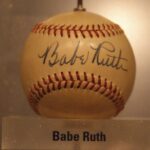
A baseball signed by ‘Babe’ Ruth in the “ball wall” of the Yankee Museum. 28 February 2010, Author Shamblesuk, GNU Free Documentation License.
Jack Sullivan worked for thirty years as a Boston firefighter, earning a good pension from all his hard and dangerous work. During his long career, Jack lived frugally, saving money to put the kids through college. After he retired in 2014, however, Jack decided to spend some of his pension and additional money he earned from a part time job on sports memorabilia related to his beloved Red Sox and the lifting of the infamous “Curse of the Bambino” with the 2004 World Series. His wife, Charlotte, also an avid Sox fan, encouraged the effort. She figured Jack never had time for hobbies while he was “on the job” so now was the time.
The “Curse” remains stuff of baseball legend. George Herman “Babe” or “the Bambino” Ruth (February 6, 1895 – August 16, 1948) was a star “slugger” for the Boston Red Sox who helped the team win three World Series before being ignominiously traded to the New York Yankees to help mortgage Fenway Park and fund a Broadway musical. After that trade, the fortunes of the hated Yankees soared while those of the beloved Sox sank with a series of heartbreaking losses in championship games over an 80-year plus period. The curse was finally “lifted” with a come from behind win against the Yankees in the American League Championship Series and a four-game sweep against the St. Louis Cardinals to cap both the 2004 season and the 100th World Series.

L to R: Babe Ruth, Bill Carrigan, Jack Barry, and Vean Gregg of the Boston Red Sox, 1916, Library of Congress, digital ID ggbain.20081
Superstitious fans attributed the Sox’s change in fortunes to two events linked to the great Bambino himself. First, late in the 2004 season, a young fan who lived his whole life on what had been the Babe’s farm was bloodied while trying to catch a fly ball hit off the bat of another Boston star “slugger,” Manny Ramirez. Then, hours before Boston’s first championship game against the Yankees, contractors began to demolish a Watertown, Massachusetts home tied to the tragic death of the Babe’s estranged wife, Helen.
As one might imagine, such stuff of legend has also generated a taste for memorabilia for items as diverse as a “bloody sock” Sox ace pitcher Curt Schilling wore in a World Series game to wood recovered from Helen’s demolished home. As luck would have it, Charlotte’s uncle, George, lived nearby, and was able to snatch what looked to be a floorboard from the property, which he gifted to Jack. That very piece of wood, which Jack mounted on a commemorative plaque, would later become the start of Jack’s “Lifting the Curse of the Bambino” collection.
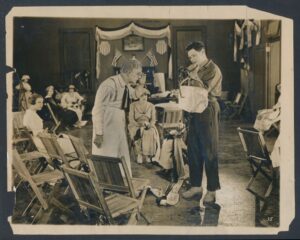
Studio photograph from the early Babe Ruth film Heading Home (1920) showing Ruth as a young schoolboy showing off for his teacher and lifting huge blocks of ice, 1920, Kessell & Baumann / Yankee Photo Corporation, public domain.
With retirement, Jack started spending real money on his collection. While the $92,000 price tag for the bloody sock was too rich for Jack, he has still been able to purchase a range of sports collectibles including an autograph associated with the Babe’s time in Boston and a signed jersey worn by Manny Ramirez. At this point, Jack figures his collection is worth almost $10,000.
But can Jack really be certain that all these items are what they purport to be? That is where warranties come in. Most legal problems that arise from purchasing sports memorabilia and other collectibles relate to the accuracy of descriptions about authenticity, type, quality, grade, rarity or provenance. The most important way for a buyer to protect himself is to obtain warranties from the seller that provide some assurance the item is what it purports to be. Warranties can be expressed or implied. Express warranties are guarantees that are considered part of any sales contract. Implied warranties arise from industry standards that come into play when describing particular goods.
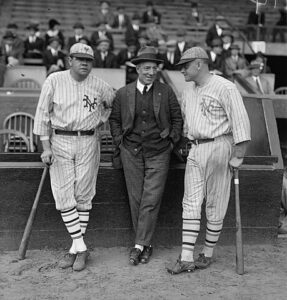
Babe Ruth and Jack Bentley in Giants uniforms for an exhibition game; famous baseball recruiter Jack Dunn in middle, October 1923, George Grantham Bain Collection, Library of Congress, Call number LC-B2- 6073-7[P&P].
The sports memorabilia business is particularly fraught. Jack is fortunate he only started putting together his “Lifting the Curse of the Bambino” collection after some of the worst abuses were exposed. As the result of scandals, particularly related to fake autographs, both New York and California have passed laws requiring dealers to provide certificates of authenticity for such items. The advent of third-party services that grade and authenticate items has also increased buyer security. Here too, however, it is incumbent on the buyer to only rely on services that are recognized as reliable leaders in the field.
Just because a dealer has been “a player” for years is no guarantee. NBC recently produced an expose about a well-known dealer who sold thousands of dollars of sports collectibles with faked autographs to another retired fireman. The dealer in question had first become famous years ago after purchasing and selling material from the estate of baseball great Joe DiMaggio.
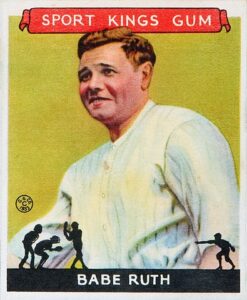
1933 Goudey Babe Ruth #149 PSA NM-MT 8, Source Heritage Auctions, public domain.
Good thing Jack is far more careful and only purchases items for his own “Lifting the Curse of the Bambino” collection from dealers with good reputations after also verifying that they were authenticated by legitimate third-party services. As a result, Jack has some assurance that both his Babe Ruth autograph and his signed Manny Ramirez jersey are authentic. And, of course, Jack knows that the piece of wood that started it all must be real. After all, everyone knows that Charlotte’s uncle, George, who gave the piece to Jack, is an upstanding guy.
This article is a public resource for general information and opinion about cultural property issues and is not intended to be a source for legal advice. Any factual patterns discussed may or may not be inspired by real people and events.
[1] Peter K. Tompa is a semi-retired lawyer who resides in Washington, D.C. He has written extensively about cultural heritage issues, particularly those of interest to the numismatic trade. Peter contributed to Who Owns the Past?” (K. Fitz Gibbon, ed. Rutgers 2005). He formerly served as executive director of the Global Heritage Alliance and now is a member of its board of directors. (https://global-heritage.org/)
Next Installment: William Penn Survives Cancellation
Further Reading:
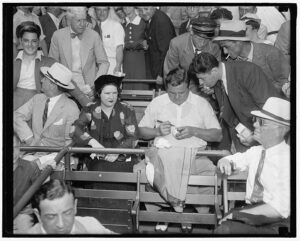
“The Bam still a favorite.” Washington D.C. July 7. Although out of baseball for the last few years, “Babe” Ruth still retains his popularity with the millions of baseball fans the country over. With Mrs. Ruth the “Babe” is shown autographing a ball for an admirer at the All-Star game today at Griffith Stadium. 7/7/37, Harris & Ewing, photographer, Library of Congress, digital ID hec.22986.
On Warranties
Armen R. Vartian and Laura C. Tiemestra, Buying and Selling Art and Collectibles, A Legal Guide (ABA 2022)
On the Curse of the Bambino
Christopher Klein, What Was the Curse of the Bambino—and How Was Baseball’s Greatest Hex Broken?, History Channel (September 30, 2021, updated May 16, 2023).
On Sport Memorabilia
Chris Bambaca, Curt Schilling’s 2004 bloody sock (not that one) up for auction, USA Today (March 12, 2021).
What not to collect in sports memorabilia, Valuables, Chubb (undated).
On Fraud in the Industry
Rich Schapiro, Stephanie Gosk, Kenzi Abou-Sabe and Kevin Monahan, Foul Ball: Did a N.J. man get duped into buying $100K in bogus sports memorabilia?, NBC News (August 9, 2019).
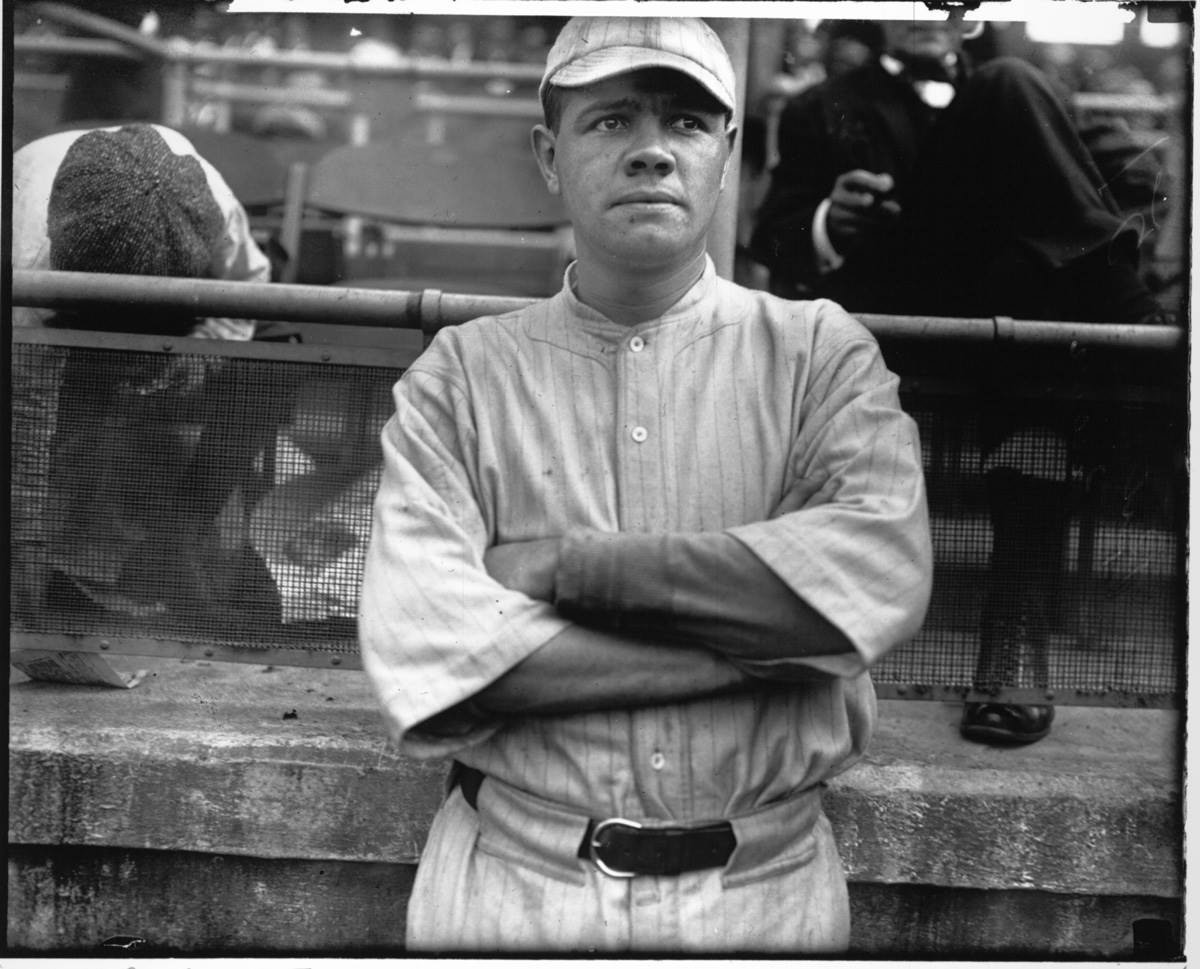 Babe Ruth, aka "The Great Bambino" at 20 years old, playing as a pitcher for the Boston Red Sox, 1915,
Source Underwood & Underwood, public domain.
Babe Ruth, aka "The Great Bambino" at 20 years old, playing as a pitcher for the Boston Red Sox, 1915,
Source Underwood & Underwood, public domain. 

